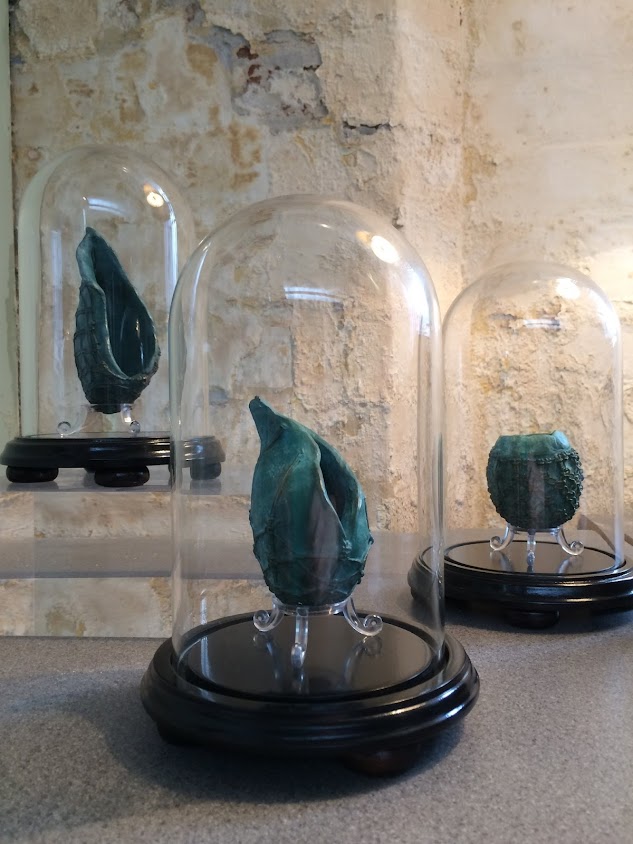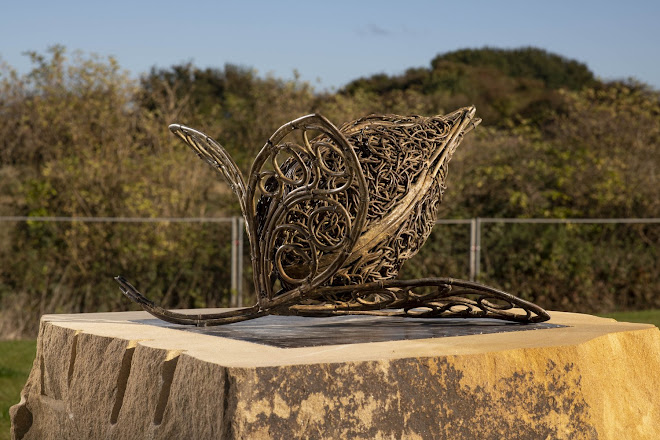Sculptor Rachel Carter works from The Garden Studio on the Derbyshire/Nottinghamshire border. She uses the lost wax technique to create bronze works on a large scale for the garden and smaller, intimate sculptures for the home. All of this work inspired Carter to eventually create Standing In This Place.
“Throughout my professional practice, since graduating with a BA Hons in Applied Arts, I have found myself driven by process and material in sculpture. For the 400th anniversary of the Mayflower sailing in 2020, I was commissioned to create a new series of work for the Pilgrim Roots districts. The ‘Pilgrim Woman’ sculptures combined my hand-woven work alongside community weaving, which was cast in bronze, a plus life-size pilgrim stands in the Danum Gallery, Doncaster, a smaller version on the banks of the River Trent in Gainsborough, and the third Pilgrim Sculpture is in Boston, Lincolnshire.”
“Many of my commissions are underpinned by my love of history and ancestry, and I feel honoured to be able to represent our shared and complex histories within sculpture. Looking at my own ancestry often inspires new work as I add to the long legacy of weavers, knotters and makers stretching back over 350 years of the Midlands industrial past.”
Standing In This Place is an arts and heritage project co-created by sculptor Rachel Carter & the Legacy Makers, in response to the work of the Legacy Makers group Est. 2014 by Bright Ideas Nottingham and the collaborative community-academic Global Cotton Connections project. It looks to highlight the contributions and connections between white mill workers and black enslaved women uprooted to the Americas, showing how their stories and histories are connected by cotton, sorrow, strength and resilience.
Through collaborating with the black-led community group Legacy Makers, we have been questioning who is and who should be remembered. While also being aware that less than 5% of statues in the UK portray non-royal women.
This ambitious project, exhibitions and new sculpture will give representation to the under-represented and give voice and recognition to the contributions of thousands of unnamed women connected through cotton and help to ‘challenge the 5%’.
"The title 'Standing In This Place' originated in my quest to find female ancestors. My family is deeply rooted in the Midlands, and I found my working-class ancestors mainly working in the textile and coal industries.
When trying to find places and connections to my female ancestors, I often discover that no trace remains. When looking at illiterate female ancestors, it’s hard to find any information about who they were other than that they were born, married, had children, and died.
Newspapers in the National Archives have been very useful in helping me understand the lives of some of these women. For example, I discovered one such story about a female lacemaker: aged 19, she was arrested for drunk and disorderly conduct at Weekday Cross, Nottingham. When I visit the Lace Market area of Nottingham, particularly the Weekday Cross, I can stand where my female ancestors once stood.
The idea behind the sculpture's title was to be able to stand where my ancestors once stood. When I began working with the black-led community group Legacy Makers, I discovered the difficulties they face when tracing ancestors of African origin. The ability to discover information about their ancestors, their roots, and the places they once stood becomes much more difficult.
When thinking about the sculpture that we are creating and its intended placement in the Broad Marsh new public park, it feels like a very fitting location as census data for the 18th & 19th centuries show many female textile workers living in the Broad Marsh and Narrow Marsh areas, you can clearly see many workers, immigrants and paupers all living side-by-side in close conditions.
The two women featured in the sculpture are our connection to our ancestors. We tread in their footsteps, and we stand in this place."
- Carter.
(Minature Shell Forms)
This miniature collection features delicate bronze sculptures that fit into the palm of your hand. They are displayed in a glass bell jar inspired by natural history collections of sea creatures that create a protective home around them.
Each miniature was hand carved directly in wax and featured intricate macramework using fine waxed cotton thread worked directly onto the sculpture's surface. Transformed into bronze using the traditional lost wax technique, they have a green patina and are polished in beeswax.
(Bronze Seeds)
In 2021, Rachel was commissioned to create a series of way markers for Redrow Homes' new housing development on the outskirts of Derby City. Durose Country Park’s circular nature walk will include four bronze seeds depicting common seeds from the countryside. The Maple, Elm, Horse Chestnut, and Sycamore seeds are woven first in wax and then cast in bronze using the traditional direct lost wax method.





No comments:
Post a Comment